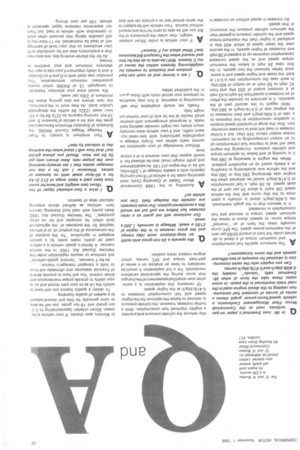In Mr. Ivan Swatman's paper on gas turbines, read at
Page 51

If you've noticed an error in this article please click here to report it so we can fix it.
the Commercial Motor Fleet Management Conference, a vehicle speed/horse-power graph shows a series of curves of constant fuel consumption relating to the diesel engine used in the road trials mentioned in the paper. In some cases these take the form of what Mr. Swatman calls "islands", notably the 0.40Ib.bhp/h and 0.411b.bhplh curves.
Can you explain why the same consumption is obtained for example at two different speeds and the same horsepower?
AThe minimum specific fuel consumption
and maximum torque of a diesel is obtained under full load at around 50/60 per cent of the maximum-power speed. The SFC curve normally takes the form of an "inverted" torque curve; at speeds above or below the optimum speed, torque is reduced and fuel consumption is increased.
It is relevant that in the graph mentioned, the 0.40113.bhp/h island is virtually a point close to the bhp curve and that the vehicle speed (38 mph) is about 54 per cent of the peak speed. At 38 mph, a fuel consumption of 0.411b.bhp/h would be obtained when the engine was developing 280 bhp or 360 bhp and the vehicle was accelerating or travelling at a steady speed up an equivalent gradient.
When the engine is operating at 280 bhp it is running at well below its optimum torque and cylinder pressure. Increasing the engine load will tend to improve fuel consumption up to an output corresponding to its maximumtorque output (about 340 bhp), but a further increase in load will tend to increase consumption. Over the range of constant-speed outputs in question consumption at first improves to a rate of 0.401b.bhp/h and then increases to the original rate of 0.411b.bhp/h at 360 bhp.
With regard to the second part of the question, it is pertinent to consider the effect of an increase in speed from 34 mph to 43 mph at a constant output of 300 bhp and from 42 mph to 50 mph at an output of 400 bhp. In each case the consumption rate is 0.41 at both the lower and higher speed and is somewhat better between the two speeds. In the first case 34 mph is below the maximum torque speed and as the speed increases consumption improves up to a speed of 38 mph and increases at higher speeds. In the second case the lower speed at which 400 bhp is produced is higher than the maximum torque speed and the cylinder pressure is greater than the optimum cylinder pressure (for economy) at that speed.
An increase in speed without an increase in bhp reduces the cylinder pressure and provides a slightly improved fuel consumption. With a further increase, however, the cylinder pressure is reduced to below the optimum for the higher speed and fuel consumption increases to 0.411b.bhp/h at the higher speed.
Of necessity this explanation is a somewhat over-simplified assessment of the cha nges that occur during the operational variations mentioned. For a full explanation it would be necessary to base an analysis on a series of part-load torque and SFC curves, which engine makers rarely publish.




































































































